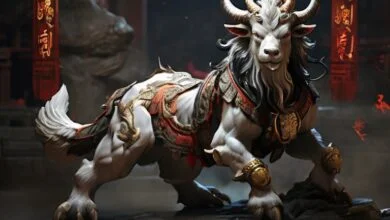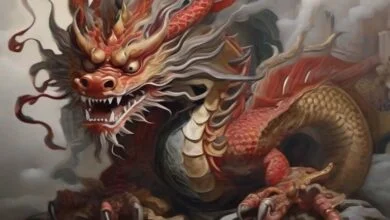
Table of Contents
Introduction
The Qilin, also known as the Chinese unicorn, is one of the most fascinating and revered mythical creatures in Chinese folklore. Known for its benevolent nature, it is often associated with prosperity, peace, and virtue. This article delves into the origins, historical and literary references, cultural significance, artistic representations, and unique traditions associated with the Qilin, providing a comprehensive overview of this legendary creature.
Origins and Mythology
The Qilin is an integral part of Chinese mythology and is considered the first of the five major mythical creatures in Chinese culture, alongside the dragon, phoenix, turtle, and pixiu. Each of these creatures holds significant symbolic value, with the Qilin embodying prosperity, serenity, and benevolence.
Physical Description
The Qilin’s appearance is a blend of various animals, each feature symbolizing different virtues. According to the ancient text «Ru Yi Tu», the Qilin has a sheep’s head, wolf’s hooves, and a colorful body, standing about four meters tall. Other descriptions from texts such as the Er Ya and Shan Hai Jing mention its dragon-like scales, lion-like mane, and a tail similar to that of an ox. This amalgamation of features signifies the Qilin’s role as a creature of balance and harmony.
Linguistic Origins
The Chinese term «Qilin» originates from the now-extinct Tocharian word «kilyom(o),» which means «noble, sacred, heaven.» The image of the Qilin was introduced to China during the pre-Qin period. The word «Qilin» is mentioned as early as the Spring and Autumn period in the text Guanzi.
Mythological Origins
In Chinese mythology, the Qilin is said to appear only during the reign of a wise and just ruler, signifying the arrival of a golden age. The creature’s presence is considered a divine endorsement of the ruler’s virtue and benevolence. According to legend, the Qilin is a peaceful creature that avoids harming any living being. It is said to tread so lightly that it does not crush the grass underfoot, further emphasizing its gentle nature.
Origins Linked to Dragons and Horses
The Qilin’s origins are often linked to dragons and horses, which are both significant animals in Chinese culture. Dragons symbolize power and strength, while horses represent speed and endurance. The Qilin, embodying qualities of both, signifies a harmonious blend of these powerful traits. Some legends suggest that the Qilin has dragon-like scales and a horse-like body, further cementing its status as a creature of great importance.

Historical and Literary References
The Qilin has been referenced in numerous classical Chinese texts, reflecting its significance in Chinese culture and history. These references provide insights into the evolving perceptions of the Qilin over the centuries.
Zhou Dynasty
During the Zhou Dynasty, the Qilin was celebrated in poetry and literature. In the poem «Zhou Nan: The Toes of the Qilin», the Qilin is praised for its gentle and virtuous nature. The Spring and Autumn Annals mention the capture of a Qilin during a hunting expedition in the 14th year of the reign of Duke Ai of Lu (481 BCE), which was considered an auspicious sign.
One of the earliest and most significant appearances of the Qilin is linked to the founding of the Zhou Dynasty. According to legend, when King Wen of Zhou was imprisoned by the Shang Dynasty, a Qilin appeared and delivered an auspicious message. The creature was believed to have foretold the rise of the Zhou Dynasty, which would bring an era of righteousness and stability. This appearance was interpreted as a divine sign supporting the legitimacy and future success of the Zhou rulers.
Warring States Period
During the Warring States period, the Gongyang Zhuan described the Qilin as a benevolent creature that appears only during the reign of wise and just rulers. The Er Ya dictionary from the same era depicts it as having a body like a deer and the tail of an ox with a single horn.

Han Dynasty
In the Han Dynasty (206 BCE–220 CE), the Qilin’s appearance was often linked with the era’s sage rulers. For example, The Records of the Grand Historian by Sima Qian recounts an incident where Confucius, upon seeing a captured Qilin, foresaw his impending death, interpreting its appearance as a sign of the end of an era. The Book of Rites further identifies the Qilin as one of the four sacred creatures, revered for its moral purity and associated with longevity and peace.
Confucius, one of China’s most revered philosophers, was reportedly born under extraordinary circumstances involving the Qilin. According to historical records and myth, a Qilin appeared near his mother, Lady Yan, during her pregnancy. This event was considered a heavenly omen indicating that her child would become a person of great wisdom and moral integrity. The Qilin’s appearance was seen as a sign that Confucius would profoundly influence Chinese philosophy and ethics.
Tang Dynasty
During the Tang Dynasty (618–907 CE), the appearance of the Qilin was recorded in texts celebrating its divine nature and its role in folklore as a harbinger of auspicious events. Emperor Taizong of Tang, for example, reportedly saw a Qilin during his reign, which was considered a sign of his virtuous rule.
During this period, the renowned monk Xuanzang embarked on his famous pilgrimage to India to retrieve sacred Buddhist texts. According to legend, as Xuanzang journeyed westward, he encountered a Qilin who guided and protected him. This divine creature not only symbolized the emperor’s favor but also served as a guardian on his perilous journey, underscoring the intertwining of spiritual quest and divine intervention in Chinese history.
Ming and Qing Dynasties
In the Ming (1368-1644 CE) and Qing (1644-1912 CE) dynasties, the Qilin continued to be a potent symbol of good governance and moral integrity. The creature was often depicted in imperial art and architecture, symbolizing the emperor’s divine right to rule. During these periods, the Qilin was also associated with the legendary sage-emperor Fuxi, who was said to have received the «River Diagram» (a map revealing the mysteries of the universe) from a Qilin.
In the late Qing Dynasty, Empress Dowager Cixi, a powerful figure in Chinese history, reportedly experienced an encounter with a Qilin. Legend has it that a Qilin appeared during a time of crisis, bringing hope and stability to the tumultuous period. This event was interpreted as a celestial endorsement of Cixi’s rule and her efforts to stabilize and reform the Qing Dynasty amidst internal and external challenges.
Cultural Significance and Traditions
The Qilin holds a prominent place in Chinese culture, with various traditions and practices associated with it. These traditions highlight the creature’s role as a symbol of peace, prosperity, and moral integrity.
The Qilin Dance
One of the most fascinating traditions involving the Qilin is the «Qilin Dance,» a performance art combining music, dance, martial arts, and acrobatics. This dance, particularly popular during festivals in Dongguan, symbolizes joy and good fortune. Performers don elaborate Qilin costumes and engage in coordinated movements, mimicking the creature’s graceful and powerful presence. The Qilin Dance is often performed during Chinese New Year and other significant celebrations to bring good luck and dispel evil spirits.

Qilin and Fertility
In Chinese folklore, the Qilin is also associated with fertility and the blessing of children. According to legend, the Qilin would bestow offspring upon deserving families. This belief led to the term «Qilin child,» referring to a particularly talented or virtuous child. It is said that before Confucius was born, a Qilin presented his mother with a jade tablet predicting his future as a great leader and sage.
Architectural Decorations
The Qilin’s image has been a staple in Chinese art and architecture. It frequently appears in decorative motifs on roofs, doors, and temples, serving both aesthetic and protective functions. The Qilin is often depicted alongside dragons and phoenixes in imperial palaces and tombs, such as those of the Ming Dynasty emperors and other significant historical sites. These depictions are believed to protect the buildings from evil spirits and ensure the prosperity of their inhabitants.
Giraffe Connection
During the Ming Dynasty, giraffes were brought to China from Africa, and they were identified as Qilins due to their unique appearance. The Ming Dynasty Emperor Yongle received a giraffe as a tribute from the Sultan of Malindi in 1414. The Emperor interpreted this as a sign of his virtuous rule, and the giraffe was celebrated as a living Qilin. This historical event reflects the flexibility of the Qilin’s image and its incorporation into real-world phenomena.

Artistic Representations and Symbolism
The Qilin has been a subject of artistic inspiration for centuries, appearing in various forms of Chinese art and literature. Its depiction has evolved over time, reflecting changing cultural values and aesthetic preferences.
Paintings and Sculptures
The Qilin has been depicted in numerous paintings, sculptures, and other forms of visual art. These artistic representations often highlight the creature’s majestic and benevolent nature. In traditional Chinese paintings, the Qilin is often shown in a serene landscape, symbolizing harmony and peace. Sculptures of the Qilin are commonly found in temples and palaces, serving as guardians and symbols of protection.
Literary Works
The Qilin has also been featured in many literary works, both ancient and modern. Classical Chinese literature often uses the Qilin as a metaphor for virtuous and wise individuals. In modern literature, the Qilin continues to be a symbol of purity and moral integrity, appearing in novels, poems, and even children’s stories.
Modern Interpretations
In contemporary times, the Qilin continues to inspire artists and writers. Its image is used in various forms of decorative arts, including jewelry and home ornaments, believed to bring luck and ward off evil spirits. The Qilin has also been integrated into popular culture and modern storytelling, maintaining its relevance in contemporary Chinese society.
Conclusion
The Qilin is a creature of immense cultural and historical significance in Chinese folklore. From its mythological origins to its depiction in art and literature, the Qilin embodies the virtues of peace, prosperity, and moral integrity. Its presence in traditions such as the Qilin Dance and its association with fertility and protection highlight its enduring relevance in Chinese culture. The Qilin’s ability to adapt to different cultural contexts, as seen in the giraffe connection, further underscores its timeless appeal. As a symbol of good fortune and harmony, the Qilin continues to inspire and captivate people around the world, making it a truly iconic figure in Chinese mythology.

Click here for more mythological creatures!

